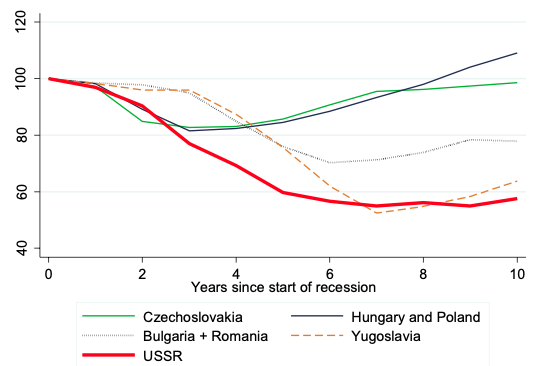Over the course of the 20th century, the number of independent states in the world more than doubled. More recently, independence movements in Scotland and Catalonia have demonstrated that state breakup remains a real possibility. Economists have not been ignorant of these developments. An impressive array of theories explains why states may disintegrate (Alesina and Spolaore 2003, Bolton and Roland 1997). However, economists have typically been silent on the economic consequences of state breakup. This is only changing slowly (Reynaerts and Vanschoonbeek 2016). For example, the historical experience of Yugoslavia has been used to illustrate that severe welfare losses can arise from violent breakup (Rodríguez-Pose and Stermšek 2014).
Using evidence from the breakup of the Soviet Union, I show that political disintegration can indeed lead to large losses in GDP (Suesse 2018a). As Figure 1 indicates, despite a relatively peaceful breakup, output losses in the (former) Soviet Union were as large as those in (former) Yugoslavia. Crucially, this new research shows that these output falls are due to disrupted trade relationships, and that these disrupted trade links can be causally attributed to independence movements.
Figure 1 Output during the 1990s in Central and Eastern Europe
Disintegration economics: A framework
Prior to the mid-1980s, the Soviet Union was a tightly integrated economic space. For the 15 Union republics that made up the upper layer of the Soviet federal hierarchy, trade-to-GDP ratios were comparable to those of contemporary EU member countries. The high extent of domestic integration in the Soviet Union was the outcome of deliberate planning, and of the fact that the Union constituted an arbitrarily closed economic area. By forcibly locking member republics into the same economic space for the foreseeable future, the planner made intra-Union trade integration the best strategy for each member. I use a game theoretical model to show that, as long as membership in the Union remained stable, and borders perfectly closed, it was indeed in the best interest of local republican elites to cooperate and trade according to the plan. In fact, portraying the Union as ‘eternal’ was a key feature of Soviet propaganda. As the first line of its national anthem proudly boasted, it was “an unbreakable union of free republics”.
The Union lost its aura of eternal cohesion during the tenure of Mikhail Gorbachev as Soviet leader (1985-1991). Gorbachev loosened the iron grip on the republics, and eased the persecution of separatist leaders. The result was a growth in secessionist movements, culminating in unilateral declarations of autonomy from many republican leaders. These declarations were not independence declarations (which generally came later), but they did signal that a republic was moving closer towards an exit. The model shows that under this scenario of uncertain commitment to the Union, decreasing domestic trade volumes became the optimal strategy for each member republic.
Political disintegration and trade
If this interpretation of the link between political disintegration and trade disintegration is correct, we should expect trade volumes to have declined most severely for those republics most likely to exit the Union. I test this prediction using a standard empirical gravity model applied to Soviet inter-republican trade between 1987 and 1991. Trade volumes are modelled as a function of republic and year fixed effects and bilateral controls, with the dyadic declarations of autonomy serving as an indication of the likelihood of a given trade pair breaking up. I find these autonomy declarations to be significantly associated with subsequently declining trade volumes.
To what degree is this relationship between political disintegration and trade causal? After all, republics with lower trade volumes would have had less to lose by exiting and may hence have been more likely to issue declarations of autonomy. I employ two sources of exogenous variation for these autonomy declarations. Using these variables as instruments, the effect of autonomy declarations on trade disintegration persists, and can be interpreted causally.
The first variable affecting the motivation to secede is extra-Union trade potential (Alesina et al. 2000). For example, the Baltic republics, which were close to large trade partners in Europe, would gain more from leaving than republics in Central Asia. Crucially, given that extra-Union trade was negligible for most republics during Soviet rule, extra-Union trade potential does not directly affect domestic Soviet integration.
The second source of exogenous variation in the propensity to secede which comes from state history. Whereas some regions, such as Belarus, had been part of a Russian state for centuries, others, such as Moldova, where more recent acquisitions. This played an important role in shaping regional attitudes towards the central authorities in Moscow. More recent acquisitions were more likely to witness the appearance of nationalist movements, and hence were more likely to break away earlier. State history, nationalism and the associated drive to secede constituted, as Suny (1993) described it, “the revenge of the past” for the Soviet state.
The output collapse reconsidered
Using extra-Union trade potential or state history as sources of exogenous variation shows that the causal effect of autonomy declarations on trade disintegration was indeed strong. A secessionist republic, which submitted its declaration 1% earlier, saw its trade volumes fall by 4.7%. As such, political disintegration can explain a large part of the fall in domestic trade.
The fall in output was commensurately large. As they were still part of the Union until the end of 1991, republics that had declared their autonomy could not yet orient their trade towards trade partners outside the Soviet bloc. Falls in intra-Union trade could therefore not be quickly compensated. Supply lines were severed, leaving factories short of inputs and consumers short of food (Nove 1991).
Quantitively, the results indicate that a one standard deviation fall in intra-Union trade volumes attributed to the likelihood of secession triggered a decline in output at the republican level of 5.4 percentage points per year. The economic consequences of exiting the Union were therefore strongly negative, at least in the short run.
Conclusion: Lessons from the Soviet breakup
This research also sheds new light on the causes of state breakup. Secessionist republican leaders were motivated by trade potential outside the Union, as well as by legacies of independent statehood. It is worth emphasising that protest data from the Soviet Union show grassroots support for secession to be similarly motivated by legacies of statehood (Suesse 2018b). Concerns about foreign trade potential, however, seem to have been unique to secessionist leaders.
Moreover, the Soviet breakup describes a situation where trade volumes and output fell as a reaction to expected, rather than actual, exits. Actual secessions lagged behind autonomy declarations by 1-2 years. This highlights the role of uncertainty surrounding secessions and the negative repercussions this might have on present output. In a similar vein, recent research has provided evidence that uncertainty surrounding the modalities of Brexit has already reduced both growth and investment in the UK, even though the rules of the common market are still in operation (Bloom et al. 2018).
Finally, the output fall due to the Soviet disintegration was so large because reorientation to new trade partners outside the former Union was hampered by several factors. Firstly, the process of transition to a market economy meant that the basic institutions necessary for integration into world markets were lacking at first. Secondly, barriers of a political nature inhibited the outward reorientation of many former Soviet countries. Those that were able to overcome these barriers, such as the Baltic countries, were able to recuperate the losses of disintegration within a decade. For those countries, such as Ukraine, that were caught between integration with western markets and Russia, the Soviet disintegration had more persistent effects.
References
Alesina, A and E Spolaore (2003), The size of nations, MIT Press.
Alesina, A, E Spolaore and R Wacziarg (2000), “Economic integration and political disintegration”, American Economic Review 90(5): 1276-96.
Bloom, N, S Chen and P Mizen (2018), “Rising Brexit uncertainty has reduced investment and employment”, VoxEU.org, 16 November.
Bolton, R and G Roland (1997), “The break-up of nations: A political economy analysis”, Quarterly Journal of Economics 112(4): 1057-1089.
Nove, A (1991), Economic history of the USSR, 1917–1991, Penguin.
Reynaerts, J and J Vanschoonbeek (2016), “The economics of state fragmentation”, VIVES discussion paper 52.
Rodríguez-Pose A and M Stermšek (2014), “The economics of secession: Case of the former Yugoslavia”, VoxEU.org, 21 November.
Suesse, M (2018), “Breaking the unbreakable union: Nationalism, disintegration and the Soviet economic collapse”, Economic Journal 128(615): 2933-2967.
Suesse, M (2018b), “Adjusting the size of nations: Empirical determinants of separatism and the Soviet breakup”, Journal of Comparative Economics, forthcoming.
Suny, R G (1993), The revenge of the past: Nationalism, revolution and the collapse of the Soviet Union, Stanford University Press.



